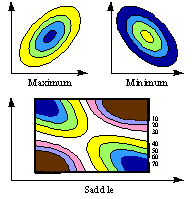Intermediate Design of Experiments (DOE Intermediate) is based on classical approaches to Design of Experiments. These highly statistical methods are very powerful engineering tools for building in quality early in the design stage.
Intermediate DOE - Steepest Ascent
 Steepest Ascent has been a traditional method of process optimization. Although they are tedious and rigorous methods from a statistical stand-point they are nevertheless powerful methods of optimization. Canonical Forms allow rotation of axes and Composite Designs allow various types experimentation. Steepest Ascent has been a traditional method of process optimization. Although they are tedious and rigorous methods from a statistical stand-point they are nevertheless powerful methods of optimization. Canonical Forms allow rotation of axes and Composite Designs allow various types experimentation.
Steepest Ascent allows you to:
- Study 2 factor optimization
- Fit a first order model (y = aA + bB...)
- Fit a second order model (y = aA + bB + jA2 + kB2 + mAB...)
- Construct canonical forms
- Establish Eigenvectors
- Characterize stationary points
- Conduct experiments using composite designs
Intermediate DOE - Nearly Uniform Information
 Nearly Uniform Information is used to study the locus of constant variance in designed experimental methods. They are supplementary to design techniques in that they allow the researcher to visualize variability as a function of distance from the design center. Nearly Uniform Information is used to study the locus of constant variance in designed experimental methods. They are supplementary to design techniques in that they allow the researcher to visualize variability as a function of distance from the design center.
Nearly Uniform Information allows you to:
- Study the locus of constant variance in designed experimental methods
- Compare different designs
- Compare the effect of adding or deleting experimental points
|









